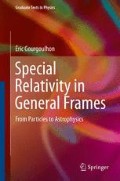Abstract
Accelerated observers are discussed in detail, first on the specific case of a uniformly accelerated observer, leading to the concept of Rindler horizon. The difference between local rest spaces and simultaneity hypersurfaces, which coincide for non-accelerated observers, is computed in terms of the four-acceleration. Next, some aspects of physics in an accelerated frame are considered: the problem of clock synchronization, the behaviour of a rigid ruler, the motion of free particles and the redshift of spectral lines. Finally Thomas precession is investigated and applied to the motion of a gyroscope carried by an accelerated observer.
Access this chapter
Tax calculation will be finalised at checkout
Purchases are for personal use only
Notes
- 1.
Let us recall that a has the dimension of the inverse of a length and that, \(\overrightarrow{\boldsymbol{a}}\) being a spacelike vector, \(\left \|\overrightarrow{\boldsymbol{a}}\right \|_{\boldsymbol{g}} = \sqrt{\overrightarrow{\boldsymbol{a} } \cdot \overrightarrow{\boldsymbol{a}}}\) [cf. Eq. (1.19)].
- 2.
Let us recall that O(t) stands for the position of \(\mathcal{O}\) at the proper time t.
- 3.
- 4.
Gerald J. Whitrow (1912–2000): British cosmologist and historian of science.
- 5.
In view of the result (12.44), we may omit the qualifier local in the denomination of \(\mathcal{E}_{\boldsymbol{u}}(t)\).
- 6.
In the previous sections, we have denoted by x 0 the x-coordinate of observer \(\mathcal{O}^{\prime}\); here we rather use x em, which recalls that he is an emitter.
- 7.
- 8.
The inertial observer \(\mathcal{O}_{{\ast}}\) in our language.
- 9.
Underlined by us.
References
Born M., 1909, Die Theorie des starren Elektrons in der Kinematik des Relativitätsprinzips, Annalen der Physik 30, 1; http://gallica.bnf.fr/ark:/12148/bpt6k15334h.image.f7; Eng. tr.: http://en.wikisource.org/wiki/The_Theory_of_the_Rigid_Electron_in_the_Kinematics_of_the_Principle_of_Relativity
Einstein A., 1907, Über das Relativitätsprinzip und die aus demselben gezogenen Folgerungen, Jahrbuch der Radioaktivität 4, 411; errata in Einstein (1908); http://www.soso.ch/wissen/hist/SRT/E-1907.pdf Eng. tr. in Beck and Havas (1989), p. 252.
Einstein A., 1908, Berichtigungen zu der Arbeit: “Über das Relativitätsprinzip und die aus demselben gezogenen Folgerungen”, Jahrbuch der Radioaktivität 5, 98; http://www.soso.ch/wissen/hist/SRT/E-1907.pdf Eng. tr. in Beck and Havas (1989), p. 316.
Einstein A. & Rosen N., 1935, The Particle Problem in the General Theory of Relativity, Phys. Rev. 48, 73.
Jackson J.D., 1998, Classical Electrodynamics (3rd edition), John Wiley & Sons (New York).
Jantzen R.T., Carini P. & Bini D., 1992, The Many Faces of Gravitoelectromagnetism, Annals of Physics 215, 1; errata in http://arxiv.org/abs/gr-qc/0106043
Jonsson R., 2006, A covariant formulation of spin precession with respect to a reference congruence, Class. Quantum Grav. 23, 37.
Jonsson R., 2007, Gyroscope precession in special and general relativity from basic principles, Amer. J. Phys. 75, 463.
Laue M., 1907, Die Mitführung des Lichtes durch bewegte Körper nach dem Relativitätsprinzip, Annalen der Physik 23, 989; http://gallica.bnf.fr/ark:/12148/bpt6k153304.image.f993 Eng. tr.: http://en.wikisource.org/wiki/The_Entrainment_of_Light_by_Moving_Bodies_According_to_the_Principle_of_Relativity
Milne E.A. & Whitrow G.J., 1938, On a linear equivalence discussed by L. Page, Zeitschrift für Astrophysik 15, 342.
Minkowski H., 1909, Raum und Zeit, Jahresberichte der deutschen Mathematiker-Vereinigung 18, 75; reprinted the same year as a book by B.G. Teubner (Leipzig et Berlin); http://de.wikisource.org/wiki/Raum_und_Zeit_%28Minkowski%29; Eng. tr. in Lorentz et al. (1923), p. 73, and in http://en.wikisource.org/wiki/Space_and_Time
Misner C.W., Thorne K.S., & Wheeler J.A., 1973, Gravitation, Freeman (New York).
Rindler W., 1966, Kruskal Space and Uniformly Accelerated Frame, Amer. J. Phys. 34, 1174.
Rindler W., 1969, Essential Relativity — Special, General and Cosmological, Van Nostrand Reinhold (New York).
Rindler W., 1991, Introduction to Special Relativity (2nd edition), Oxford University Press (New York).
Rowe E.G.P., 1984, The Thomas precession, Eur. J. Phys. 5, 40.
Rowe E.G.P., 1996, Rest frames for a point particle in special relativity, Amer. J. Phys. 64, 1184.
Sommerfeld A., 1910b, Zur Relativitätstheorie II: Vierdimensionale Vektoranalysis, Annalen der Physik 33, 649; http://gallica.bnf.fr/ark:/12148/bpt6k153366.image.f663 reprinted in Vol. II of Sommerfeld (1968), p. 217; Eng. tr.: http://en.wikisource.org/wiki/On_the_Theory_of_Relativity_II:_Four-dimensional_Vector_Analysis
Thomas L.H., 1926, The Motion of the Spinning Electron, Nature 117, 514.
Thomas L.H., 1927, The Kinematics of an Electron with an Axis, Philosophical Magazine and Journal of Science 3, 1.
Author information
Authors and Affiliations
Rights and permissions
Copyright information
© 2013 Springer-Verlag Berlin Heidelberg
About this chapter
Cite this chapter
Gourgoulhon, É. (2013). Accelerated Observers. In: Special Relativity in General Frames. Graduate Texts in Physics. Springer, Berlin, Heidelberg. https://doi.org/10.1007/978-3-642-37276-6_12
Download citation
DOI: https://doi.org/10.1007/978-3-642-37276-6_12
Published:
Publisher Name: Springer, Berlin, Heidelberg
Print ISBN: 978-3-642-37275-9
Online ISBN: 978-3-642-37276-6
eBook Packages: Physics and AstronomyPhysics and Astronomy (R0)

